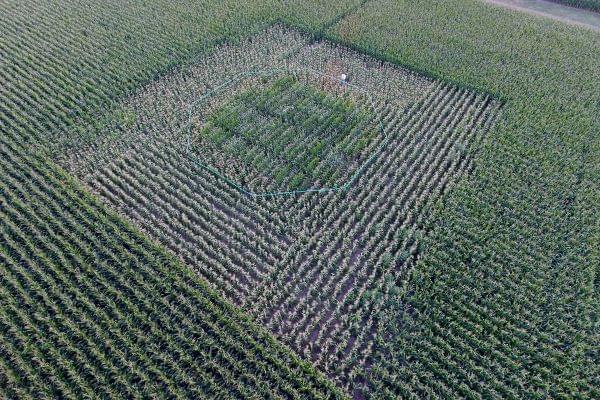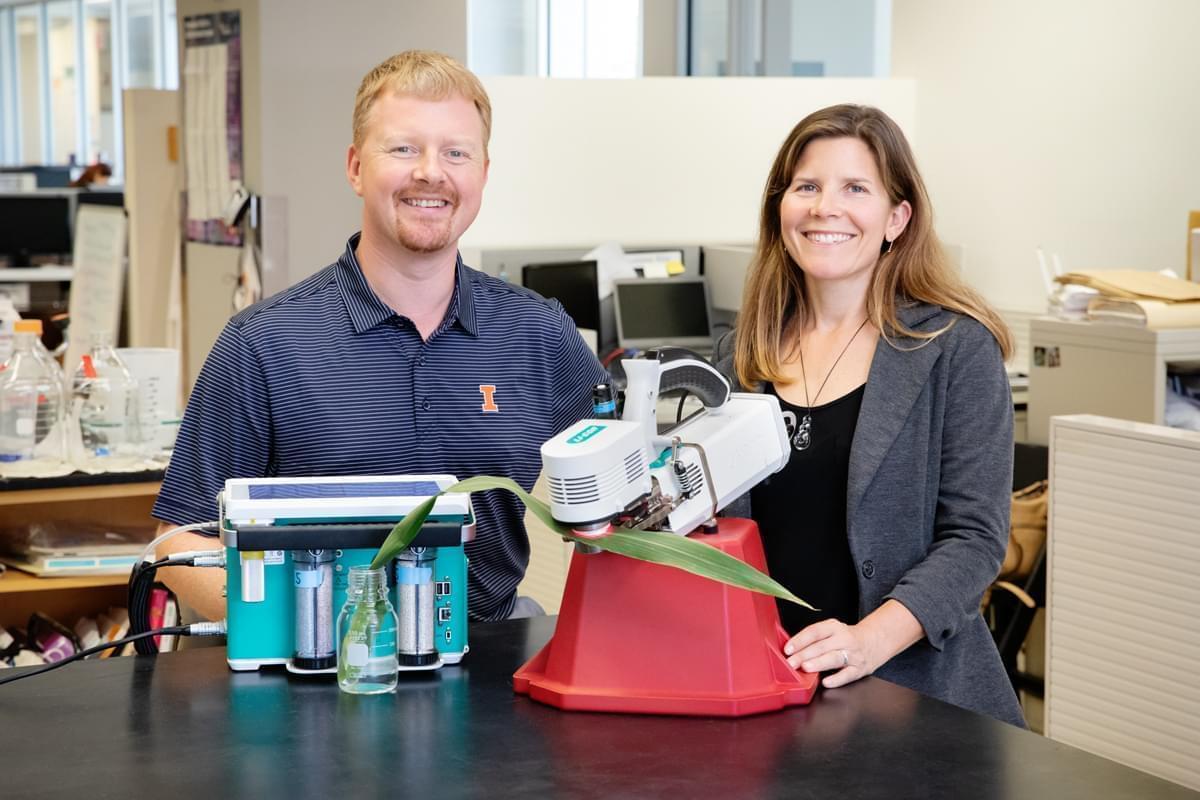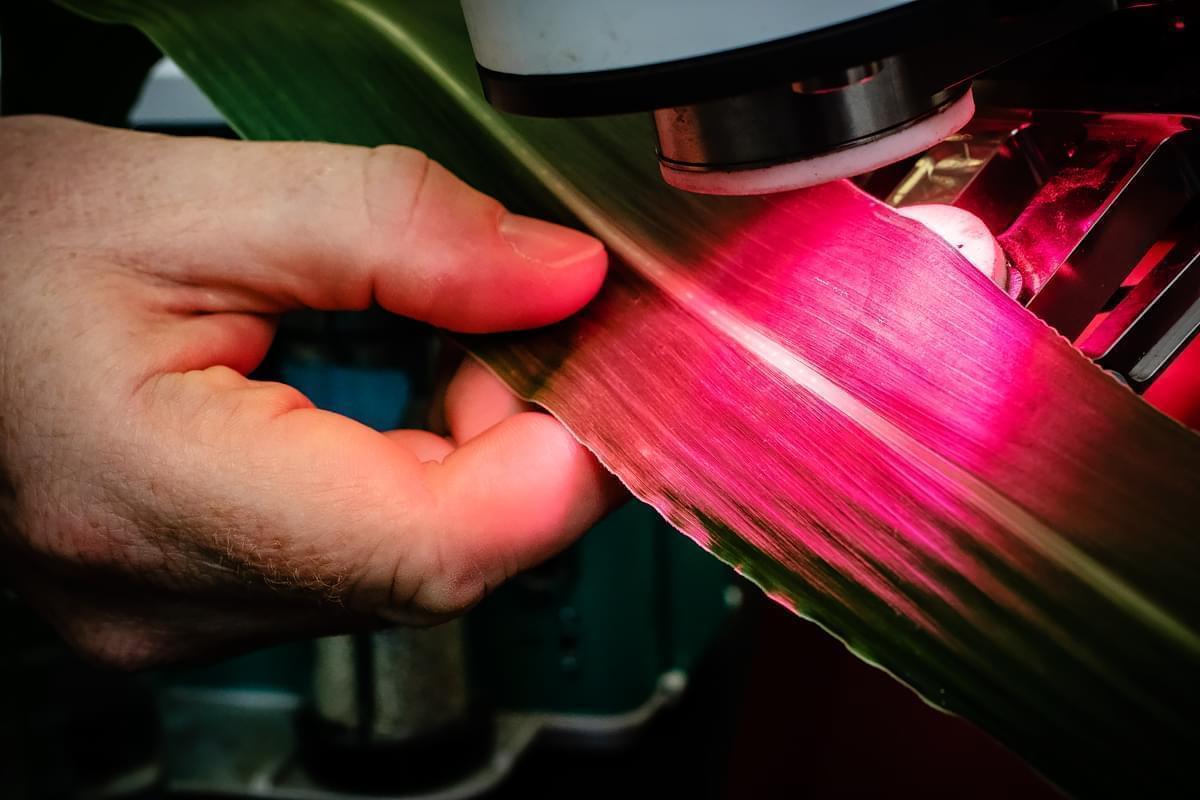Rising Ozone Harms Some Corn Varieties More Than Others, New U Of I Study Finds

The Free Air Concentration Enrichment facility at the University of Illinois’ South Farms allows scientists to dose agricultural fields with varying levels of atmospheric gases, including ozone. James Baltz/Courtesy of U of I Public Affairs
Ozone is an air pollutant that forms when emissions from cars, power plants and other sources chemically react in the presence of sunlight. The highly reactive molecule is hazardous to human health and can also harm plants by hindering photosynthesis in plant leaves.
New research from the University of Illinois at Urbana-Champaign reveals that certain maize varieties are more susceptible than others to damage caused by rising ozone levels.

U.S. Department of Agriculture scientist Lisa Ainsworth, right, U. of I. plant biology professor Andrew Leakey and their colleagues found genetic variation in the way that corn plants respond to ozone pollution. The offspring of some genetic lines suffer greater yield losses than others when exposed to elevated ozone levels in the field.
U of I plant biology professor Andrew Leakey is one of the lead authors of the study, which was published in the journal Global Change Biology.
He said the degree to which ozone levels affect different plant varieties is not well-understood, in part because it’s really hard to study.
To better understand the potential threat of ozone to corn agriculture, Leakey and his colleagues planted 45 hybrid corn plants representing all the major types of corn—popcorn, sweet corn, dent, flint and others—in an outdoor facility located south of the U of I campus in Urbana known as the Free Air Concentration Enrichment facility, or FACE.
The field has “arrays of pipes that can release ozone-enriched air in a very controlled way over the experimental plots,” Leakey said. “They do that over the whole lifetime of the plant, without any enclosures or greenhouses. So it's a totally normal farmer's field, but with this change in the composition of the atmosphere.”
The research team found two varieties of corn, in particular, were more sensitive to elevated ozone levels; their offspring were also more susceptible to ozone, regardless of which other types of corn they were bred with.
“You can’t pick up that distinction under normal, clean-air conditions,” Leakey said. “So it would be a bit like discovering you are mildly asthmatic the first time you visit a very badly polluted city but you didn’t know beforehand.”
Leakey said prior studies suggest that current ozone levels are already causing harm to maize production.
“My colleagues here have done previous studies showing that over the last few decades, corn farmers in the Midwest at the U.S. have probably lost about 5 to 10 percent of their productivity to ozone,” he said. “That’s a very real number when you look at the size of the U.S. corn crop.”
Andy VanLoocke is an assistant professor of agronomy at Iowa State University. He collaborates with Leakey on other research projects and worked at the FACE facility when he was a grad student at the U of I; but he was not involved in this new study.
VanLoocke said the new study is the first to “show a path forward with how to actually deal with reducing the impact of ozone on corn in the Midwest,” as breeders can use the information to develop more ozone-resistant maize hybrids.

Researchers evaluate the photosynthetic traits of corn exposed to high ozone levels. In this experiment, a researcher measures the rate at which gas exchange occurs in a corn leaf.
Additionally, conducting the study in the FACE facility, “where the corn is growing as similarly as possible to what would be the real conditions,” VanLoocke said, produces more reliable data.
“Whereas, if you were to do these studies in a greenhouse or in a chamber, where the corn doesn’t actually grow fully through maturity, and doesn’t have the same kind of uptake of nutrients or water or (carbon dioxide), then you'd have to go second- or third-hand when it comes to transferring your findings to the real world,” he said. “So this is really a hard study to do, it takes a lot of work and a lot of funding to do a study like this, but it really is worth it to be able to move more quickly on this evidence than we otherwise would’ve been able to do.”
Genetic analyses revealed certain sets of genes that were unique to more ozone-sensitive corn plants. Since the genetics of commercial corn are a trade secret, there’s no way to know if the corn varieties grown by farmers in the Midwest contain those genes.
However, Leakey said seed companies that are interested in creating varieties that are more likely to hold up against rising ozone could use the technique developed at the U of I to potentially accomplish that.
Future studies will focus on understanding the genetic underpinnings of the differences in ozone susceptibility, he said.
Follow Christine on Twitter: @CTHerman
Links
- Yellow, White Or Both, An Ear Of Sweet Corn Is A Summer Pleasure
- Grasses Better Than Corn For Ethanol Production, Says New Study
- Monsanto Claims News GMO Corn Produces Bigger Ears
- USDA Boosts Corn, Soybean Harvest To New Records
- USDA: Illinois Corn, Soybean Crops Excelling
- ‘This Is All Wrong,’ Greta Thunberg Tells World Leaders At U.N. Climate Session
- Student Activists Prepare For Climate Strike; Police And Home Surveillance Cameras; Fall TV Preview
- Illinois’ Agriculture Sector Pitching In To Save The Monarch Butterfly
- Study: Intensive Agriculture Drives Midwest Climate Changes

